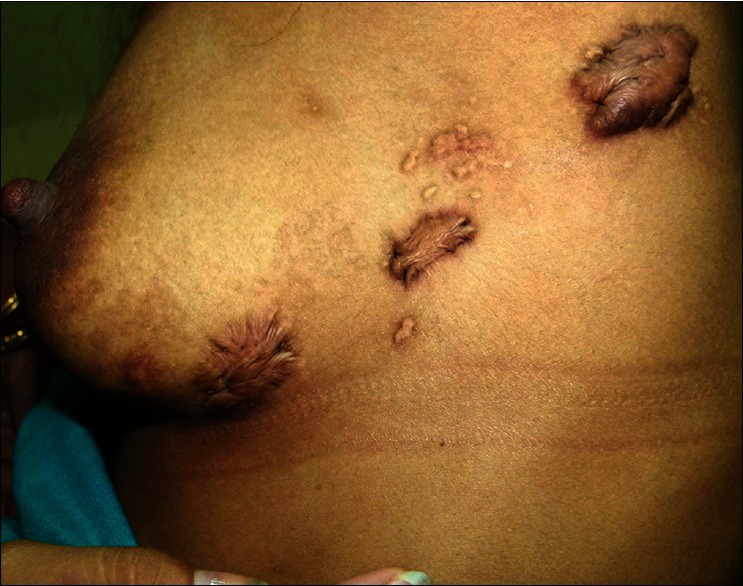Sir,
A 28-year-old woman came to the clinic with healed herpes zoster (HZ) scars in the T5, T6 dermatome and persistent pain in that area since the episode [Figure 1]. She developed HZ last year when she was 28 weeks pregnant. Her dermatologist advised her against any oral antivirals. Her HIV status was negative and still is. About 4 weeks later, she noticed her scars becoming prominent and gradually starting to showing keloidal features. From her history, she had a typical episode of HZ. She did not develop deep, necrotic lesions or have a secondary infection. She had a normal delivery and the child is in good health. She had no history or signs of scars or keloids and had a negative family history. She said that her keloids were itchy and painful sporadically. She also had post-herpetic neuralgia. The pain was lancinating in nature, sporadic, prominent in some positions, present between the keloids and around them in the entire dermatome. It did not respond adequately to NSAIDs, 1200 mg of gabapentin, which made her dizzy and somnolent, and 150 mg of pregabalin. She has been treated with intralesional triamcinolone acetonide 40 mg/ml and oral antihistamines for the itching. We await her response upon follow-up after one month.
Figure 1.

Keloids in T5, T6 dermatome
Keloids are benign connective tissue tumors developing due to an aberration in the normal wound-healing process. Darker skin types have a higher risk of keloid formation. Several cytokines and hormones are involved in keloid pathogenesis such as epidermal growth factor and tumor growth factor beta 1. Both are negatively correlated to scar formation. Melanocortin-1 receptor and alpha-melanocyte-stimulating hormone, activin-A, and follistatin are overexpressed in keloids and hypertrophic scars.[1–3] Both activin-A and follistatin are involved in the establishment and maintenance of pregnancy and are expressed and secreted by stromal endometrial cells.[4]
Keloids developing in healing herpes zoster have been reported from India in an HIV positive woman.[5] A host of other sequelae have been described including erythema multiformae and segmental leukocytoclastic vasculitis, the latter two by the co-author.[6–8] In our case, HZ was responsible for local trauma leading to keloids. We hypothesize that pregnancy with increased expression of keloidal activin-A/follistatin and dark skin type are cofactors for the development of post-herpetic keloids. An association of pregnancy and HZ eventuating in keloid formation has never been reported in dermatological literature to the best of our knowledge. Oral antivirals administered during the episode probably would have prevented post-herpetic neuralgia (PHN) to some extent and this was made worse in our patient by the pain and itching of keloids.[9]
REFERENCES
- 1.Muffley LA, Zhu KQ, Engrayv LH, Gibran NS, Hocking AM. Spatial and temporal localization of the melanocortin 1 receptor and its ligand α-melanocyte-stimulating hormone during cutaneous wound repair. J Histochem Cytochem. 2011;59:278–88. doi: 10.1369/0022155410397999. [DOI] [PMC free article] [PubMed] [Google Scholar]
- 2.Kim YS, Lew DH, Tark KC, Rah DK, Hong JP. Effect of recombinant human epidermal growth factor against cutaneous scar formation in murine full-thickness wound healing. J Korean Med Sci. 2010;25:589–96. doi: 10.3346/jkms.2010.25.4.589. [DOI] [PMC free article] [PubMed] [Google Scholar]
- 3.Mukhopadhyay A, Chan SY, Lim IJ, Phillips DJ, Phan TT. The role of the activin system in keloid pathogenesis. Am J Physiol Cell Physiol. 2007;292:C1331–8. doi: 10.1152/ajpcell.00373.2006. [DOI] [PubMed] [Google Scholar]
- 4.Florio P, Gabbiani M, Borges LE, Bonaccorsi L, Pinzauti S, Reis FM, et al. Activins and related proteins in the establishment of pregnancy. Reprod Sci. 2010;17:320–30. doi: 10.1177/1933719109353205. [DOI] [PubMed] [Google Scholar]
- 5.Goel SK, Kuruvila M. Rare sequelae of herpes zoster in HIV positive patient. Indian J Dermatol Venereol Leprol. 2002;68:295. [PubMed] [Google Scholar]
- 6.Requena L, Kutzner H, Escalonilla P, Ortiz S, Schaller J, Rohwedder A. Cutaneous reactions at sites of herpes zoster scars: An expanded spectrum. Br J Dermatol. 1998;138:161–8. doi: 10.1046/j.1365-2133.1998.02045.x. [DOI] [PubMed] [Google Scholar]
- 7.Wollina U, Gemmeke A. Herpes zoster-associated erythema multiforme. J Dermatol Case Rep. 2009;3:11–3. doi: 10.3315/jdcr.2009.1025. [DOI] [PMC free article] [PubMed] [Google Scholar]
- 8.Wollina U, Schönlebe J. Segmental leukocytoclasticvascultitis in herpes zoster. Int J Dermatol. 2012;51:1351–2. doi: 10.1111/j.1365-4632.2011.05167.x. [DOI] [PubMed] [Google Scholar]
- 9.Parruti G, Tontodonati M, Rebuzzi C, Polilli E, Sozio F, Consorte A, et al. VZV Pain Study Group. Predictors of pain intensity and persistence in a prospective Italian cohort of patients with herpes zoster: Relevance of smoking, trauma and antiviral therapy. BMC Med. 2010;8:58. doi: 10.1186/1741-7015-8-58. [DOI] [PMC free article] [PubMed] [Google Scholar]


